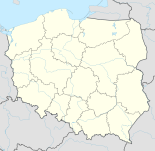Drohiczyn
| Drohiczyn | ||
|---|---|---|

|
|
|
| Basic data | ||
| State : | Poland | |
| Voivodeship : | Podlaskie | |
| Powiat : | Siemiatycki | |
| Gmina : | Drohiczyn | |
| Area : | 15.68 km² | |
| Geographic location : | 52 ° 24 ' N , 22 ° 39' E | |
| Height : | 134 m npm | |
| Residents : | 2030 (December 31, 2016) | |
| Postal code : | 17-312 | |
| Telephone code : | (+48) 85 | |
| License plate : | BSI | |
| Economy and Transport | ||
| Street : | Warsaw - Bielsk Podlaski | |
| Next international airport : | Warsaw | |
Drohiczyn [ drɔˈxʲit͡ʂɨn ] is a small town in the powiat Siemiatycki of the Podlaskie Voivodeship in Poland . It is the seat of the town-and-country municipality of the same name with about 6500 inhabitants and the diocese of Drohiczyn .
Geographical location
Drohiczyn is located on the right bank of the Western Bug in the south of the Podlaskie Voivodeship, northeast Poland. The city is located on the national road that connects Siemiatycze and Włocławek .
history
Archaeological excavations show that the urban area of today's Drohiczyn was already populated during the Neolithic . In the 11th century, Drohiczyn was a fortified place on the border between Mazovia and the pagan areas in the east. The first historical mention of the city's name dates from 1142 . At the beginning of the 12th century Drohiczyn belonged to the Kievan Rus . In 1182 Drohiczyn became the capital of an autonomous duchy. For a short time the city came into the possession of Konrad I of Mazovia at the beginning of the 13th century , before Drohiczyn fell to the principality of Halitsch-Volhynia . Daniel Romanowitsch of Galicia was crowned King of the Rus ( Rex Russiae ) here in 1253 by a papal envoy . Lithuania annexed the city in 1280 . Drohiczyn received city rights in 1498 from the hands of the Grand Duke of Lithuania under Magdeburg law . 1520 was Drochiczyn capital of Podlaskie (Podlasie) and is still regarded as historical capital of Podlasie . The city was incorporated into the Kingdom of Poland in 1569.
The 16th century was a heyday for Drohiczyn. At the beginning of the 17th century there were three Catholic and five Orthodox churches and five monasteries in the city, two of which were Catholic. There was also a hospital, a pharmacy and a school. The Swedish invasion and devastation put an end to the city's development. The churches and monasteries were rebuilt or renovated in the 18th century. There were also schools run by Franciscans and Jesuits . In 1795 Drohiczyn was occupied by Prussia after the Third Partition of Poland . With the establishment of the Duchy of Warsaw in 1807, the city was divided: while the parts of the city west of the bow fell to the new duchy, the eastern parts of the city were incorporated into the Russian Empire . In 1815 Drohiczyn was reunited and came under the rule of the Russian Kingdom of Poland . The city went into decline in the 19th century. Far away from the new main traffic routes, Drohiczyn became a provincial town. The population of the city was 1775 2000 inhabitants, in 1857 there were only 835.
At the beginning of the 20th century, more and more Jews settled there, causing the city to grow again to over 2000 inhabitants. During both world wars there was repeated destruction of the city, which was rebuilt. During the Second World War, around 700 Jews were trapped in the city's ghetto by the National Socialists and finally deported to the Treblinka extermination camp and killed.
Today's Drohiczyn is a service and trade center for the surrounding areas. The picturesque character of the city also attracts tourists. Since 1991 the city has been the seat of a diocese. There are also three Catholic and one Orthodox churches in the city. Pope John Paul II's participation in an ecumenical meeting in Drohiczyn on June 10, 1999 was a highlight in the city's history .
Attractions
- Castle Hill (former fortress)
- Franciscan church and monastery
- Benedictine church with monastery
- 19th century orthodox church
- Diocesan Museum
- Regional museum
economy
- Service center for neighboring rural communities
- Timber industry
- food
- Leather manufacturing
- tourism
Gmina
In addition to the town, the town-and-country municipality of Drohiczyn includes numerous villages with around 4500 inhabitants.
